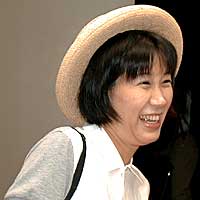
by Luis Reyes
As stylistic as the show's visual aesthetic, the music for "Cowboy Bebop," composed by Yoko Kanno, can stand alone as an aural
study of genre and tone. Compounded with the other elements of the Bebop package - a collection of work not necessarily greater
than the sum of its parts but rather a harmonious composite - the music drives a complex narrative and reflects complicated
psyches.
Yoko Kanno's career spans nearly 15 years and includes music for television dramas, commercials and video games in addition to
several diverse scores for such anime as the action-oriented "Brain Powered," the fantastical "Vision of Escaflowne" and the
transcendent "Cowboy Bebop." Unhappy at college studying literature, Kanno left the university after only a week but not before
signing on as a keyboardist for the pop act Tetsu 100%.
Recognized for arranging pop song for singers around Japan, a video game producer asked her to compose the music for one of his
products (though years later she confessed an aversion to writing for video games because of the excessive desensitizing amount
of bloodshed typical of most). Word of mouth carried and within a year Kanno was an industry favorite. Even now, a bulk of her
work is for commercials.
"In a given week I have about 2 or 3 commercial songs that have to be created," Yoko explains in an interview on @anime.com.
"I have meetings with the advertisers and I go and record the piece and then I make a demo tape out of it for the 2 or 3
commercials per week. I only select one anime piece or other piece, one per year."
Considering Kanno's consumerist proclivities, her music continues to thrive with originality, borrowing from a wealth of
musical genres and styles - just as director Shinichiro Watanabe and writer Keiko Nobumoto borrow from a wealth of screen genres
and cinematic styles in composing the conceit that is "Cowboy Bebop." Kanno and Bebop, then, fit together artistically,
indicative of a movement into a pop-culture post-modernism where disparate elements find new life and meaning when brought into a
context with each other - the noir film and the western; 60s lounge jazz with ecclesiastic choral music; the femme fatale against
the youthful genius hacker; a power ballad waltz played with the rhythm of African drums accented by blaring brass: the artistic
quintessence of a consumer culture. In this respect, her work on commercials serves to educate her musical sensibilities.
"Commercials have to get the attention of all ages, from little kids to elderly people, I learn a lot from making the
commercials so that I can grab the hearts of everyone in such a short time," she continues in her @anime interview.
Separating the music from "Cowboy Bebop" is akin to lopping off one of its limbs. So integrated with the narrative technique
is Yoko Kanno's score that Watanabe sculpts scenes in rhythm to the music, at times contrasting tragedy with sprightly
underscoring. "Ballad of the Fallen Angels" is perhaps the first time in the series that the music, images and dialogue meld
together to advance the story as a whole, and from this point on the music itself serves as a sub-textual conduit for Nobumoto's
evasive story.
Yoko Kanno has avoided the pitfalls into which many American composers who find themselves aligned with the corporate
conglomerates fall - she has simultaneously maintained a commercial, a pop and a virtuoso musical profile, embracing music as a
whole rather than discriminating between pop and art, old school and new school, jazz and rock.
|

